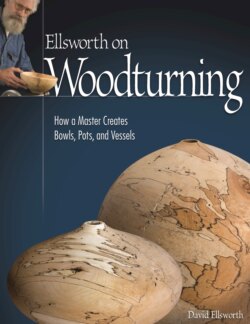Читать книгу Ellsworth on Woodturning - David Ellsworth - Страница 24
На сайте Литреса книга снята с продажи.
Friction and abrasion
ОглавлениеFriction and abrasion will cause any tool to lose its sharpness, although the various grades of high speed, powdered, and cryogenic steel available in today’s tools will extend the life of their edges to some degree. But some woods are so abrasive that they’ll quickly whack the edge off any tool. Dulling woods include root burls, which usually contain pockets of sand; eucalyptus, many species of which contain silica; and any tree with bark where the little crevices have been packed with dust by the wind while the tree was growing.
And then, of course, there are spalted woods, which are a nightmare to a freshly sharpened edge. This is because the black zone lines in spalted wood are not really wood anymore. Instead, they are mineral-based deposits left over from the spalting process as the fungi crept through the wood, destroying cell structures in their wake. As far as the tool is concerned, cutting these zone lines is more like turning seashells. One good slice, and the edge of your favorite tool is gone. That is the reason I never run spalted wood through my band saw. Sharpening the teeth on my chainsaw is lesson enough.
Spindle versus faceplate
Spindle turning is quite likely the oldest form of shaping something on the lathe, because it would have been easier for primitive cultures to trap a stick between two points and spin it than to dangle a bowl blank off the end of a shaft. And that is basically the difference between the two methods of shaping wood on the lathe. For example, chair legs, porch posts and pens are all spindles and turned between centers, while bowls, vessels, and vases are turned off the shaft supported by either a faceplate, glue block, or chuck. The three basic tools used to form spindles are the skew, gouge, and parting tool, while bowl and vessel turning primarily involves using gouges and scrapers.
